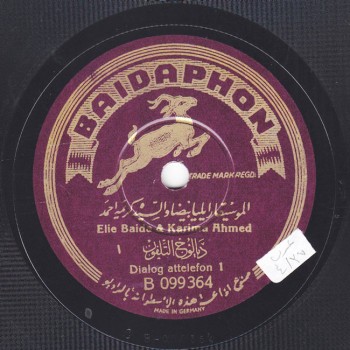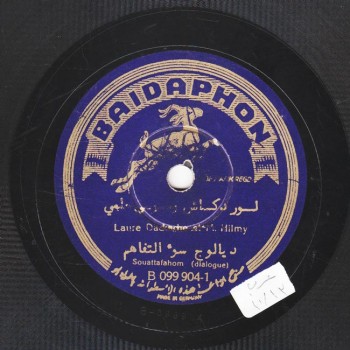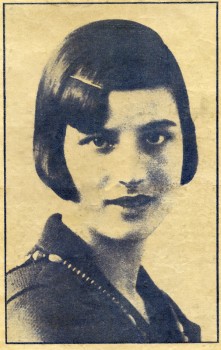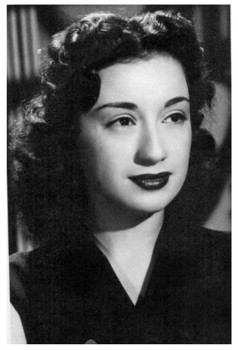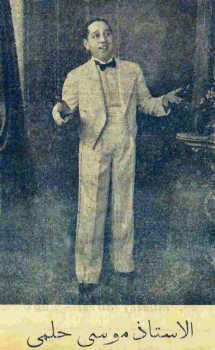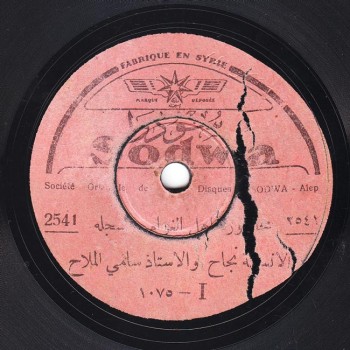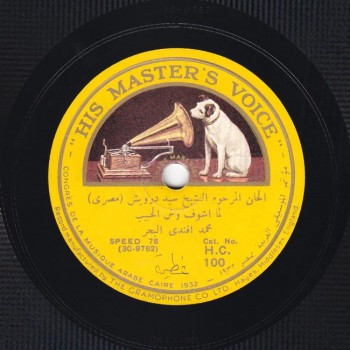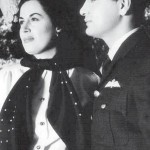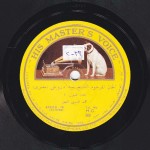The Arab Music Archiving and Research foundation (AMAR), in collaboration with the Sharjah Art Foundation (SAF), presents “Durūb al-Nagham”.
Dear listeners,
Welcome to a new episode of “Durūb al-Nagham”.
Today, we will be resuming our discussion about musical dialogues.
Since we are talking about Sayyid Darwīsh and the operetta “Shahrazād”, let us note the following point: there is a love song at the beginning of this operetta, i.e. before Za‘bulla joined the army, when he worked as a shepherd and Ḥūriyya guarded poultry, that includes animal sounds, and that demonstrates the mastery of all the performers, including Sayyid Darwīsh and Bayram al-Tūnisī, yet also the following problem –specific to the Congress’ recordings–: the person playing the role of Ḥūriyya is also a man.
But let us ignore this and listen to the Congress’ recording of Muḥammad al-Baḥr’s “Lammā ashūf wishsh el-ḥabīb”. Note the animal sounds in this ‘ushshāq tune…
(♩)
Beautiful!
Indeed.
Let us talk a little Mr. Kamal.
Go ahead.
There was some activity in the field of the singing theatre in the Levant despite the political events, i.e. the fall of the Ottomans, the French Mandate…etc., and consequently in the recording industry.
What can you tell us about this? Did you personally witness anything, or hear anybody say anything?
Our recordings related to this subject include ĪIiyyā Baiḍā who sang with several artists including Karīma Aḥmad, and Laure Dakkāsh who sang herself with Mūsa Ḥilmī.
It was always an Egyptian dialect v/s Levantine dialect dialogue, between an Egyptian and a Levantine, an Egyptian girl and a Levantine man, or “a cute girl from Beirut” …etc.
Let us listen to the telephone dialogue between ĪIiyyā Baiḍā and Karīma Aḥmad.
She accuses him of being a liar “Kadhdhāb kadhdhāb”… She is Egyptian while he lives in Beirut where he requests an international call to Cairo.
Baidaphon recorded this duet in 1937.
It is among Baidaphon’s last 78rpm recordings and includes both sung and spoken text –the accompanying takht complies– and a number of musical lāzima separating the words…
(♩)
Laure Dakkāsh also sang with ĪIiyyā Baiḍā…
Numerous muṭrib duos recorded in Brazil and in the U.S.A. including: ĪIiyyā Baiḍā with Laure Dakkāsh in the U.S.A., and Wadī‘ al-Ṣāfī with Laure Dakkāsh in Brazil… Many of these recordings were made in the U.S.A.
It may have been a way to promote their concerts in the country of immigration where many recording companies were interested in recording Arab Music, added to the companies owned by Arabs such as “Maqṣūd records”.
True.
Sitt Najāḥ sang a beautiful duet with Sāmī al-Mallāḥ.
A duet with Sāmī al-Mallāḥ recorded by Sodwa, i.e. in the late 1930s / early 1940s.
… In 1939.
They both sing beautifully.
The dialogue takes place over the phone between a person in a given city and another in Beirut.
Let us listen to this beautiful dialogue.
“Muḥāwarat ahl al-gharām”.
(♩)
Let us end our discussion about the Levant with a beautiful duet performed by Laure Dakkāsh and Mūsa Ḥilmī.
It is “Sū’ el-tafāhum”, isn’t it?
Yes, it is.
In “Sū’ el-tafāhum”, Lebanese Laure Dakkāsh plays the role of an Egyptian woman who mixes up words in Lebanese and words in Egyptian: she says for example “ṭamāṭim” (tomatoes –in Egyptian), and he answers “ṭamāṭim mā-ifhamsh” (I can’t understand the word ṭamāṭim), then she says “ ‘āyza kummitra” (I want pears –in Egyptian) and he thinks she is insulting him. He is a fruit and vegetable vendor who neither knows the meaning of kummitra –to him they are njāṣ (pears –in Lebanese)– or the meaning of ṭamāṭim (tomatoes –in Egyptian) –to him they are banadūra (in Lebanese)–…etc.
This dialogue ends with a discussion on Arab unity. This duet includes comedy yet also conveys a social message about the refusal of the separation that started in the 1920s and 1930s. The statement is the following: “We are all Arabs, wherever we come from, we are one nation”.
It was recorded by Baidaphon in 1937.
Almost, yes.
Let us listen to it…
(♩)
Dear listeners,
We have reached the end of today’s episode of “Durūb al-Nagham”.
We will meet again in a new episode to resume our discussion about Musical Dialogues.
This episode was presented to you by Mr. Kamal Kassar.
“Durūb al-Nagham”.
- 221 – Zakariyya Ahmed – 12 (1/9/2022)
- 220 – Zakariyya Ahmed – 11 (1/9/2022)
- 219 – Zakariyya Ahmed – 10 (11/25/2021)
- 218 – Zakariyya Ahmed – 9 (10/26/2021)
- 217 – Zakariyya Ahmed – 8 (9/24/2021)
- 216 – Zakariyya Ahmed – 7 (9/4/2021)
- 215 – Zakariyya Ahmed – 6 (8/28/2021)
- 214 – Zakariyya Ahmed – 5 (8/6/2021)
- 213 – Zakariyya Ahmed – 4 (6/26/2021)
- 212 – Zakariyya Ahmed – 3 (5/27/2021)
- 211 – Zakariyya Ahmed – 2 (5/1/2021)
- 210 – Zakariyya Ahmed – 1 (4/28/2021)
- 209 – W-al-Lāhi lā astaṭī‘u ṣaddak 2 (4/6/2017)
- 208 – W-al-Lāhi lā astaṭī‘u ṣaddak 1 (3/30/2017)
- 207 – Bashraf qarah baṭāq 7 (3/23/2017)

